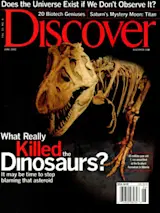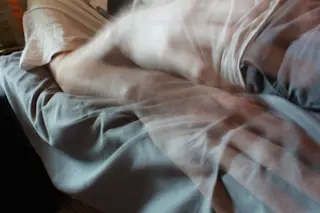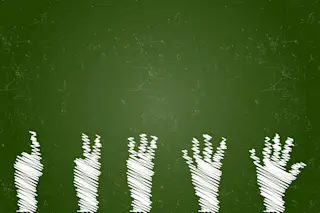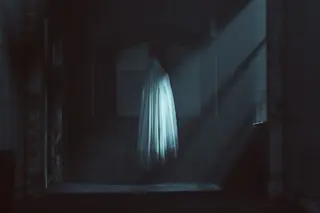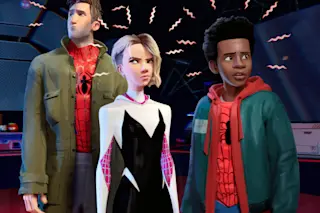
Functionalmagnetic resonance imaging, here being performed on graduate student Melissa Sáenz, tracks blood flow in the brain. UCSD researchers usedthis same technique at Stanford University, in collaboration with theSalk Institute, to chart Mike May's visua processing after his sightwas restored.
MacLeod's laboratory at theuniversity is a labyrinth of filing cabinets, optical equipment, andoddly placed desks. "It's well booby-trapped," he says, steering Maytoward the first of many tests one afternoon. "But May has an uncannyability to navigate complicated arrangements." Tall and athletic, withfeatures that look boyishly handsome despite his graying black hair,May would make a good James Bond if not for a few side effects of hisblindness. Unlike the rest of his body, his eyelids haven't had alifelong workout. Perpetually half closed, they lend a stoic blanknessto his face that's relieved only by the occasional smile. He has yet tolearn facial expressions.
Sitting obligingly in front of anancient computer monitor, May watches as thick black-and-orange barsappear on the screen. MacLeod and Fine are testing his ability to seedetail. His job is to adjust the contrast with a trackball until he canjust see the bars. A click on a mouse brings up another set of bars,thinner than the last, and he plays around with those until he can seethem too. Although his right eye ought to provide 20/20 vision, inreality it's closer to 20/500. Instead of discerning the letter Eon an eye chart from 25 feet, May can see it only from two. In the pastthe blurred vision of people with restored sight was blamed on scartissue from surgery. But stem-cell surgery leaves no scars. The signalsare reaching May's brain, but they are not being interpreted very well.
More than 300 years ago, in a famous letter to the philosopherJohn Locke, the Irish thinker William Molyneux anticipated what Maysees. A blind man who is suddenly given vision, Molyneux suggested,wouldn't be able to tell the difference between a cube and a sphere.Sight is one kind of perception and touch another; they can be linkedonly through experience.
The most dramatic proof of thistheory came in an experiment published in 1963 by Richard Held and AlanHein, who were then professors at Brandeis University in Waltham,Massachusetts. Held and Hein raised two kittens in total darkness. Butevery so often they would place the kittens in separate baskets,suspend the baskets from a single circular track, and turn on thelights. Both baskets hung just above the floor, but one had holes forthe kitten's legs to poke through; the other did not. The free-limbedcat ran in circles on the floor, pulling the other basket along behindit; the other kitten had no choice but to sit and watch. While theactive kitten learned to see normally, the passive kitten stayedeffectively blind: Its eyes could see, but its brain never learned tointerpret the sensory input.
Held and Hein's experiment hasnever been duplicated. But in the past half century, studies of sightrestoration, most notably by Oliver Sacks and Richard Gregory, haveverified that some things can't be understood without experience.Objects, faces, depth— just about everything that helps us function inthe world— are meaningless when a person who has never seen before getssight. "Babies are born into a bright, buzzing confusion, but we can'task them what it's like," Fine says. "In some ways talking to Mike Mayis like getting to talk to a 7-month-old."

IoneFine and Don MacLeod use this interferometer to shine a split laserbeam into May's eyes to test his ability to process visual information.They also run the same test on themselves. "I spend a lot of my timedown here," Fine says, "with an eye patch on and a bite bar in mymouth. It's disgusting . . . really old plastic."
Inthe first months after his surgery, May fulfilled Molyneux'sprediction: He couldn't distinguish a sphere from a cube. Since thenhis sight has improved, but only slightly. He has a better grasp ofspheres and squares ("We've shown him an awful lot of them," Finesays), and with practice he can understand things he's seen again andagain. But this is only a work-around: He's past the critical periodfor learning to recognize objects instantly.
"Two of themajor clues I have are color and context," May says. "When I see anorange thing on a basketball court, I assume it's round. But I may notbe really seeing the roundness of it." Faces give him even moretrouble. Although he has seen faces everywhere since the first day hisvision was restored, they simply don't coalesce into recognizablepeople. Their expressions— their moods and personalities— elude himentirely. Even his wife is familiar to him only by the quality of hergait, the length of her hair, and the clothes she wears. "If a face hasno hair and a fake moustache, we can still tell the gender," Fine says."But he can't deal with it. The bit of the brain that does that isn'tworking."
The best proof of this can be seen in the basement,where MacLeod's interferometer sits. Designed to test the brain'sability to process visual information, the machine works by shining asplit laser beam into a subject's eye. As the beams travel, their lightwaves interfere with each other, bypassing the optics of the cornea andprojecting a pattern onto the retina. Most subjects who sit in front ofthe interferometer will see light and dark stripes, regardless of thequality of their optics. But when May opens his eyes to receive thebeams, he sees nothing at all.
The interferometer results arebacked by fMRI scans, which track May's brain activity as it'soccurring. The scans show that when May sees faces and objects, thepart of his brain that should be used to recognize them is inactive.But there's a catch. When he sees an object in motion, themotion-detection part of his brain lights up like a disco ball. He caninterpret movement on a computer screen as well as any normal-sightedadult and seems to have the same skill in real life. "We were drivingalong, and a minivan came up to us pretty fast on his side," Fineremembers. "It whizzed by him, and he mentioned that it was going fast.That's a complicated calculation. The motion on the retina depends onhow big the car is, how close, and how fast it's going."
It'shard to escape the conclusion that motion detection, unlike every othervisual experience aside from color, is largely hardwired. The bestillustration of this may be offered, once again, by cats. "If you rolla ball along a floor, the cat will chase it as long as it's moving,"Fine says. "As soon as it's stationary, the cat will have a hard timeseeing it and will ignore it." That's why mice freeze when they'reafraid. It may also explain why May, who can barely recognize astationary ball, is pretty good at catching a moving one. It's hisfavorite use of his new sense. "I don't know who has more fun," hesays, "my 8-year-old or me."
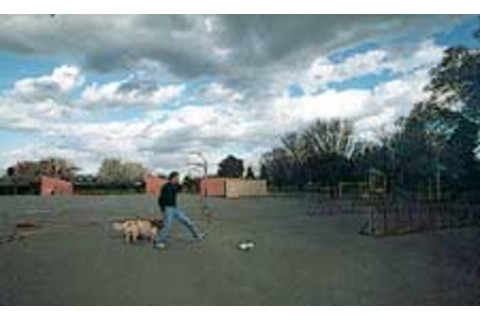
May walks down the street, he can't recognize perspective lines, so heuses visual landmarks to keep his bearings. "I'm learning one frame ata time," he says.
Blind people spend theirentire lives understanding the world through their hands. Theirmemories, their mental maps of the places they know, theirunderstanding of Labradors, doorknobs, and the moguls on a ski slopeare all tactile. The sudden introduction of a new sense can't alterthat fundamental way of experiencing the universe. Instead, any newinformation gleaned from light is simply graphed onto the original,tactile map. "The old idea that there is one picture of the world onthe surface of the cortex is way too simple," MacLeod says. "In fact,we have a couple dozen complete maps." For someone just learning how tomerge all that information, this can make for a great deal ofconfusion. But it might also offer a richer, truer sense of the worldthan the one perceived by those of us who have never been blind.
Sitting in the lab one day, MacLeod, smirking like a schoolboy who'shatching a prank, slides a drawing across the table to May. On thepaper are four cubes. The top right cube and the bottom left cube aredark; the other two are light. The drawing is shaded as if light werecoming from above, so the tops of the squares are lighter than theirfronts. This makes the top of the dark square the same shade as thefront of the light square. Experience tells us that the top of the darkcube has been brightened by a hidden light, but it still seems darkerthan the front of a light cube. It's an illusion based on knowledge.Naturally, May doesn't fall for it.
"He's actually closer toreality," Fine says. "We once showed him two circles— a small one closeto him and a larger one farther away. To you or me they would haveappeared to be the same size. But when we asked, 'What's the apparentsize?' he couldn't understand. He kept saying, 'I know it's biggerbecause it's far away.'" Similarly, May's tactile experience withhallways and highways tells him that their sides are parallel, so hesimply can't perceive converging lines of perspective. "A hallwaydoesn't look like it closes in at all," he says. "I see the lines oneither side of the path, but I don't really think of them as comingcloser in the distance." He pauses to mull this over. "Or maybe my minddoesn't believe what my mind is perceiving. When I see an object, itdoesn't look different to me as I circle around it. I know orange conesaround vehicles are cones because of context, not because I'm seeingthe shape. If I picture looking down on a cone, it still looks like acone."
Learning to see, for May, is really about learning tofall for the same illusions we all do, to call a certain mass of colorsand lines his son, to call another group of them a ball.
OneApril morning, only weeks after his eye surgery, May took his skis andhis family up to the Kirkwood Mountain Resort in the Sierra Nevadas— aplace he knew like the texture on the back of his hand. This was wherehe had first learned to ski and where he had later met his wife. Thesun was out, the trees were green (greener than he'd imagined), and theslopes were surrounded by gorgeous cliffs (were they miles away or justa few hundred yards?). As the lift churned above, skiers in puffyparkas flitted by, popping into his field of vision. His wife, actingas a guide, had to remind him to stop gawking and ski.
Withonly one working eye, May already lacked depth perception. But he alsohad little experience reading the shades and contours of a landscape.Heading down the mountain, he could hardly distinguish shadows frompeople, poles, or rocks. At first, he tried to compute the lay of theland consciously: If a certain slope was being lit from the side and ashadow fell in such a way, then the slope must be convex. But once hehit his first bump, he was tempted to close his eyes and ski the way heknew and loved.
Only a handful of adults have ever seen theworld through the eyes of a newborn, and many who did came away wishingthey were still blind. Their family and friends had convinced them thatvision would offer a miraculous new appreciation and understanding ofthe world. Instead, even the simplest actions— walking down stairs,crossing the street— became terrifyingly difficult. Dispirited anddepressed, about a third of them reverted back to the world of theblind, preferring dark rooms and walking with their eyes shut.
If May feels differently, it may be because his expectations were solow. For a man who used to enjoy windsurfing blind and alone, able moreoften than not to return to the pier from which he'd started, sight isjust another adventure in a life of invigorating obstacles. Two yearsafter his return to Kirkwood Mountain, May has learned to match what hesees on a ski slope with his repeated physical experience of it. "Hehas jury-rigged himself quite a functional little system," Fine says."He knows that this kind of shadow makes this bump, this kind makesanother." Instead of closing his eyes on even the easiest slopes, hecan now negotiate moguls without a guide.
"People have thisidea that it's so overwhelmingly practical to have sight," May says. "Isay it's great from an entertainment point of view. I'm constantlylooking for things that are unique to vision. Running and catching aball is one of them— I've been chasing balls my whole life. Seeing thedifference between the blue of my two sons' eyes is another. Or if youdrop something, you can find it."
The gift of sight may seemmost miraculous, in the end, to those who have never been blind. ButMay still finds things in the world to entrance him. Sitting in thepassenger seat of Fine's car one day, with his dog, Josh, panting athis feet, he ignores the blue Pacific to the left, the towering,top-heavy eucalyptus trees lining the road like something out of Dr.Seuss. Instead, he gazes at the beam of sunlight filtering through thewindow onto his lap. "I can't believe the dust is just floating in theair like this," he says. Oceans and trees, Seussean or otherwise, hehas known all his life through touch. But this glitter of dust,suspended in the bright La Jolla sun, is an entirely new awareness. Hewaves his hand through the sparkling beam. "It's like having littlestars all around you."
Do You See What I See?
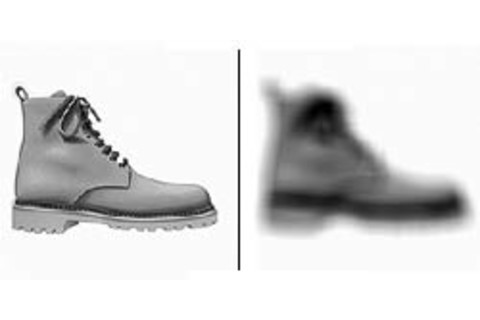
May ought to have 20/20 vision since his right eye was restored by stem-cell surgery and a corneal transplant. Instead, his vision is closer to 20/500— or about as blurry as the example to the right. "Basically, the results say that you can only get precise vision early in life at the critical period," Don MacLeod says. "We don't really know where May will end up, but he isn't approaching normal vision at a quick rate."
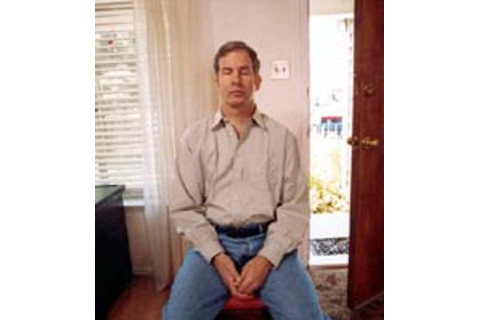
Mike May holds the world speed record for downhill skiing by a blindperson. In his competitive days he would slalom down the steepestblack-diamond slopes at 65 miles an hour, with a guide 10 feet ahead toshout "left" and "right." The directions were just obvious cues. Therest came from the feel of the wind racing against his cheeks and thesound of the guide's skis snicking over the snow. But May's days as aworld-class blind athlete are behind him. He's no longer blind.
May lost his vision at the age of 3, when a jar of fuel for a miner'slantern exploded in his face. It destroyed his left eye and scarred thecornea of his right, but over the next 43 years he never let thosedisabilities slow him down. He played flag football in elementaryschool, soccer in college, and nearly any activity that didn't involveprojectiles as an adult. He earned a master's degree in internationalaffairs from Johns Hopkins, took a job with the CIA, and became thepresident and CEO of the Sendero Group, a company that makes talkingGlobal Positioning Systems for the blind. Along the way, he found timeto help develop the first laser turntable, marry, have two children,and buy a house in Davis, California. "Someone once asked me if I couldhave vision or fly to the moon, what would I choose," he once wrote."No question— I would fly to the moon. Lots of people have sight, fewhave gone to the moon."
Then one November day in 1999, hecame back to his senses. At St. Mary's Hospital in San Francisco,surgeon Daniel Goodman dropped a doughnut of corneal stem cells ontoMay's right eye (his left was too severely damaged to be repaired). Thecells replaced scar tissue and rebuilt the ocular surface, preparingthe eye for a corneal transplant. On March 7, 2000, when the wraps wereremoved, May got his first look at his wife, his children, and for thefirst time since he was a toddler, himself.
Sight restorationis a periodic miracle— both for its recipients and for the scientistswho have the privilege of studying them. As early as the fifth centuryB.C., Egyptian surgeons used a needle to push their patients'cataract-covered lenses away from their pupils, affording them somedegree of sight. More recently, in the late 1960s, surgeons learned toremove cataracts with ultrasound. The stem-cell surgery performed onMay was developed in Japan and introduced in 1999. Since then hundredsof people have benefited from it. But of all those who have had theirsight restored throughout history, only about 20 recorded cases wereblind since childhood, and of those, most had less-than-perfect corneasafter surgery. When Goodman peered into May's eye after the surgery, hesaw a lens that ought to provide crystal-clear vision.
Itdoesn't— far from it. Pristine as his optical hardware is, May's brainhas never been programmed to process the visual information itreceives. May still travels with his dog, Josh, or taps the sidewalkwith a cane, and refers to himself as "a blind man with vision." Andthat paradox fascinates Don MacLeod and Ione Fine, experimentalpsychologists at the University of California at San Diego. The speedwith which babies learn to understand the world suggests that they'reborn with the ability to process some aspects of vision. But whichaspects, exactly? What is learned and what is hardwired? During thepast year and a half, Fine and MacLeod have put May through a batteryof physical and psychological tests, including functional magneticresonance imaging, or fMRI, which tracks blood flow in the brain. Theresults are opening the first clear view into how we learn to see.

Right: A lifetime of blindness has left May insusceptible to visual illusions. Most people would say that the top of the dark cube is darker than the front of the light cube. To May they're the same exact shade. It's only when MacLeod explains the illusion that May can even see that squares are supposed to look three-dimensional.


